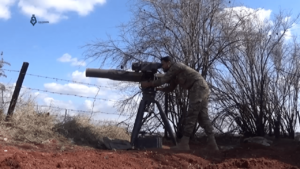Timber Sycamore facts for kids
Quick facts for kids Timber Sycamore |
|
|---|---|

Seal of the CIA
|
|
| Operational scope | Weapons sales, training of Syrian rebel forces |
| Location | Eastern Europe, Jordan, Syria |
| Planned by | Central Intelligence Agency |
| Target | |
| Date | 2012–2017 |
| Executed by | Central Intelligence Agency United States Department of Defense Jordanian Armed Forces General Intelligence Directorate (Jordan) Al Mukhabarat Al A'amah (Saudi Arabia) Qatar State Security Secret Intelligence Service (UK) |
| Outcome |
|
Timber Sycamore was a secret program run by the United States' spy agency, the Central Intelligence Agency (CIA). It was also supported by spy agencies from some Arab countries, like Saudi Arabia. The main goal of this program was to help remove the Syrian president, Bashar al-Assad, from power.
The program started in 2012 or 2013. It gave money, weapons, and training to groups in Syria who were fighting against the Syrian government. These groups are often called "rebels" or "opposition groups." The program became known to the public in mid-2016.
One problem with the program was that many US weapons, like rifles and grenades, ended up being sold on the black market in the Middle East. A black market is where things are bought and sold illegally. Some of these weapons were even sold to groups like Islamic State (IS). Some people in the US government thought the program was not working well and was too expensive. They were also worried that some weapons might go to extremist groups.
In July 2017, US officials said that the Timber Sycamore program would be stopped. The money might instead be used to fight the Islamic State or to help rebel groups defend themselves.
Contents
How the Program Started
The head of the CIA, David Petraeus, first suggested a secret plan to arm and train Syrian rebels in 2012. At first, President Barack Obama said no to the idea. But later, he agreed. This was partly because leaders from other countries, like King Abdullah II of Jordan and Israeli Prime Minister Benjamin Netanyahu, asked him to.
Timber Sycamore began in late 2012 or early 2013. It was similar to other programs the US had run before to help rebel groups in other countries. The main countries supporting Timber Sycamore were the United States and Saudi Arabia. Other Arab governments and the United Kingdom also helped. Saudi Arabia gave more money and weapons, but the United States led the training. The program was based in Jordan because it is close to Syria.
At first, the program only allowed US forces to train Syrian rebels. They were not allowed to give them weapons directly. But a few months later, the rules changed. The CIA was then allowed to both train and equip the rebel forces. Saudi Arabia provided military equipment. Other countries like Qatar, Turkey, and Jordan also secretly gave money to the rebels.
Before the program officially started, Saudi Arabia, Qatar, and Turkey sent many rifles, machine guns, and ammunition to Syrian rebels in 2012. The CIA helped Saudi Arabia buy some of these weapons. Some US officials were worried that some rebel groups being supported might have ties to Al Qaeda.
The public found out about Timber Sycamore in June 2016. This happened after a defense magazine reported that the US government was looking for companies to ship thousands of tons of weapons from Eastern Europe to Turkey and Jordan.
What the Program Did
Timber Sycamore was managed from a special center in Amman, Jordan. It gave weapons like Kalashnikov rifles, mortars, rocket-propelled grenades, and anti-tank missiles to Syrian rebel groups. It also provided night vision goggles and pickup trucks. Many of these weapons were bought in Eastern Europe. Then, they were sent to Syria through Jordan. CIA agents trained the Syrian rebels on how to use these weapons.
Experts say that at least 50 different rebel groups received weapons or training through this program. US officials said the program was very effective at first. It trained and equipped thousands of fighters, who made big gains in battles. However, the program started to lose its effectiveness after Russia began its military involvement in the Syrian Civil War.
One expert noted that the CIA program, even though it didn't remove Assad from power, was not useless. He estimated that the fighters supported by the CIA might have killed or wounded many Syrian soldiers and their allies.
It is important to know that Timber Sycamore was different from another US military program. That other program trained Syrian rebel forces specifically to fight against the Islamic State of Iraq and the Levant (ISIL). The US military made it clear that their goal in Syria was only to fight ISIL.
Sometimes, US-backed rebels fought alongside groups like al-Nusra Front, which is linked to Al-Qaeda. Some US-supplied weapons were even taken by the al-Nusra Front. This was a big worry for the US government when the program was first planned. After Russia got involved, pro-American groups started losing ground in late 2016.
The Timber Sycamore program is still mostly secret. Many details are not known, such as the total amount of support given, all the types of weapons transferred, or the exact rebel groups that received help. However, one newspaper reported that two thousand tons of old Soviet-era weapons had been sent to Jordan by April 2016.
Weapons on the Black Market
Stolen Weapons in Jordan
According to US and Jordanian officials, some weapons sent to Jordan by the CIA and Saudi Arabia were stolen. These weapons were taken by Jordanian intelligence officers and then sold on the black market.
Millions of dollars worth of weapons were stolen. US officials said that some of these stolen weapons were later used in a shooting attack in Jordan in 2015. In that attack, two American contractors and others were killed.
The stolen weapons from Timber Sycamore caused a huge increase in heavy weapons on the Middle Eastern black markets. Jordanian officials said that the intelligence officers who stole the weapons used the money to buy expensive items. Their senior officers knew about this. The thefts stopped after the US and Saudi governments complained for months. Several intelligence officers were fired, but they were allowed to keep the money they made.
Regional Weapons Smuggling
Even before the Syrian Civil War, the border area between southern Syria and northern Jordan was used for smuggling. The war made this area a major hub for smuggling weapons. The formal support from Timber Sycamore only made the smuggling worse.
Journalists found that rebels who received weapons from the program often sold some of them to local arms dealers. They did this to get money to pay more fighters. Some weapons were sold to traders who then traded them to the Islamic State group. The Islamic State would place orders using a messaging app. Some rebel commanders and a UK organization that tracks weapons said that weapons from the program ended up with IS forces.
A study in 2017 found that outside support for anti-Assad rebels greatly increased the number and quality of weapons available to ISIL. In one case, anti-tank weapons bought by the United States ended up with the Islamic State within two months of leaving the factory. However, the study did not find any cases where US weapons given to the Syrian Democratic Forces (SDF) to fight IS ended up with IS.
Ending the Program
In July 2017, officials said that President Donald Trump decided to stop supporting the anti-Assad Syrian rebel forces. This decision was made after talking with his national security advisor and the head of the CIA. The resources might be used instead to fight ISIL or for other operations in the region.
Officials said this decision was made before Trump met with Russian president Vladimir Putin. Some officials called the decision a "major concession" to Russia. One even said, "Putin won in Syria." However, another official said that ending the program was not a big concession. This was because Assad had already won many battles in the Syrian Civil War. This official said it was more of a sign that the US wanted to improve its relationship with Russia. Some people in the Obama administration had wanted to stop the program earlier. This was because some rebels trained by the program had joined ISIL and similar groups.
A separate US military program continued to arm, train, and support the Syrian Democratic Forces (SDF) in their fight against ISIL. This program also provided airstrikes and continued through 2017 and into the present.
See also
- American-led intervention in the Syrian Civil War
- Operation Cyclone, a CIA program from 1979–1992 that armed Afghan fighters against Soviet forces.
- Iran–Contra affair, a US arms sale to Iran to support a group called the Contras.
- Foreign interventions by the United States
- United States involvement in regime change





